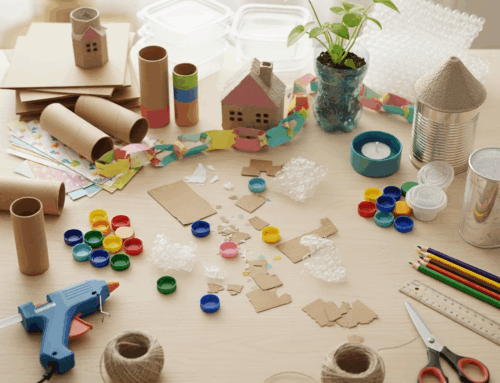Thrift stores are more than secondhand shops – they’re hubs for teaching how to reduce waste and reuse resources. Here’s how they’re making a difference:
- Workshops: Hands-on sessions show how to repurpose items like furniture or clothing, teaching practical skills.
- Community Events: Activities like clothing swaps and themed shopping nights encourage smarter consumption and connection.
- Partnerships: Collaborations with schools and organizations spread awareness and provide educational opportunities.
- Volunteer Programs: Thrift stores offer real-world experience in sorting, repairing, and managing donations, helping people build professional skills.
- Donation Education: Clear guidelines help donors and shoppers understand how their actions reduce waste and support local causes.
These efforts aren’t just about teaching – they’re creating a shift in how communities think about waste and reuse. By participating in thrift store initiatives, you’re contributing to a smarter, more resource-conscious future.
1. Upcycling and Recycling Workshops
Thrift stores nationwide have found that hands-on workshops are one of the best ways to teach people how to reuse and reimagine materials. These sessions transform shopping trips into learning experiences, showing participants the untapped potential in items that might otherwise be discarded. From here, the door opens to all kinds of creative and practical projects.
Take non-profit programs, for example – they’ve held workshops that guide participants through projects like furniture makeovers, DIY denim crafts, and jar light fixtures. These activities cater to everyone, from beginners to seasoned crafters, focusing on affordable methods that give new life to old items while cutting down on waste.
As Upcycle That puts it, “Upcycling in vocational education is more than a creative trend – it’s a hands-on way to build essential trade skills”. By combining practical skills with real-world applications, these workshops create an engaging environment where participants can immediately put what they’ve learned into practice at home.
These sessions don’t just teach crafting – they also incorporate lessons in job readiness, budgeting, and financial literacy. Participants start with smaller projects, like picture frames, to build confidence before moving on to more advanced challenges. This step-by-step approach ensures that everyone can enjoy early successes while steadily improving their skills.
One standout feature of these workshops is the access they provide to both space and materials. Items donated to thrift stores that might not sell in their original form are repurposed as project supplies. This gives attendees a chance to reimagine these goods while also promoting sustainability and responsible resource use. Some workshops even offer open crafting hours, allowing community members to experiment and refine their skills with materials they might not have considered before.
City Thrift is a great example of this movement in action. Their workshops highlight the store’s dedication to creative, sustainable practices, inspiring others to embrace resource recovery as a community effort.
2. Community Events for Better Living
Thrift stores go beyond being just places to shop – they become hubs where communities can come together, learn, and grow. By hosting events focused on sustainability and resourcefulness, these stores turn everyday shopping into a chance to connect and discover practical ways to live with more intention. From clothing swaps to themed shopping nights, these gatherings highlight how shared experiences can inspire sustainable habits.
Take clothing swaps, for instance. These events are not only great for the environment but also for fostering a sense of community. At one local swap, participants exchanged items they no longer needed for ones that sparked joy, and the event even set a new revenue record. It’s a win-win: people save money, make connections, and give new life to pre-loved items.
Themed shopping events also play a big role in promoting sustainability. Events like Back-to-School Thrift Nights, Halloween Costume Finds, and Holiday Décor Markets help families find affordable, reused alternatives while learning the importance of rethinking consumption. Some stores take it a step further with monthly “Upcycle Nights”, where attendees transform outdated clothing into trendy, personalized pieces. These gatherings blend creativity, skill-building, and community bonding. Partnering with local businesses for these events adds even more opportunities to learn and collaborate.
Guest speaker events are another way thrift stores engage their communities. For example, on July 24, 2025, the Canby Public Library hosted an event featuring experts from Clackamas County Sustainability & Solid Waste and the Canby Kiwanis Thrift Store. They shared insights on the “7 Rs” – rethink, refuse, reduce, reuse, repair, repurpose, and recycle – offering attendees a comprehensive guide to sustainable living.
City Thrift’s approach shows how thrift stores can become vibrant community centers. These events bring people together around shared values, proving that some of the best learning happens outside traditional classrooms. When neighbors unite with a shared commitment to better living, the impact is both meaningful and lasting.
3. Partnerships with Local Organizations
Thrift stores play a key role in promoting resource recovery by teaming up with schools, community centers, and local organizations. These partnerships bring resource recovery principles to life, combining shared resources, knowledge, and networks to create meaningful, hands-on learning experiences.
Educational institutions are natural allies for thrift stores aiming to expand their outreach. For instance, programs developed in collaboration with local schools not only encourage donations but also provide ongoing lessons about resource recovery. These partnerships go beyond one-time events, fostering long-term relationships where schools benefit from both materials and educational support. The results speak for themselves: they demonstrate how collective efforts can drive measurable change.
Take ReUSE at the University of California, Berkeley as an example. During the 2022–23 academic year, they donated $2,971.51 worth of supplies and repurposed an impressive 1,112.3 pounds of materials. This success story shows how thrift store initiatives can seamlessly integrate into educational institutions’ sustainability goals while delivering tangible results.
Some collaborations blend education with community service. At the University of Utah, the Sustainability Office runs “What Goes Around Comes Around (WGACA)”, a pop-up thrift shop held twice a year. Students donate gently used items at the end of each semester, which are then made available for free at the start of the next semester. Leftover items are donated to local organizations like Big Brothers Big Sisters. Emma Miller, a student intern with the Sustainability Office, sums up the initiative’s broader purpose:
“I also hope that this event encourages students to focus more on reuse and buying less. It’s good for the wallet and great for the planet.” – Emma Miller, Student Intern in the Sustainability Office
Thrift stores also team up with local organizations to create community-wide educational programs. A standout example is the Davis Street Education Center, which teaches students about waste management and landfill history while focusing on the four Rs: reduce, reuse, recycle, and compost. This 1,500-square-foot facility features seven interactive exhibits and has welcomed over 15,000 school children since opening in June 1995.
City Thrift takes a similar approach, partnering with schools and community groups to extend its educational reach. These collaborations highlight their dedication to both community service and sustainable practices.
Beyond education, these partnerships also offer specialized training opportunities. Thrift stores provide real-world settings for programs like job training, master composter courses, and commercial auditor training. These hands-on experiences not only reinforce sustainable habits but also pave the way for broader community learning and engagement.
4. Volunteer and Job Training Programs
Thrift stores double as hands-on learning spaces, offering volunteers and trainees real-world experience in resource recovery and sustainable practices.
For example, volunteers at places like Haven House Thrift Stores gain practical skills by sorting, organizing, and displaying donated goods. These efforts not only keep usable items out of landfills but also support broader missions, such as aiding men in recovery from alcohol and drug addiction. Beyond basic tasks, volunteers are trained in areas like visual merchandising, pricing, and inventory management – skills that tie directly to the economic aspects of resource recovery. While these activities provide valuable experience, structured job training programs take it a step further by preparing participants for long-term career opportunities.
Building on volunteer experiences, job training programs focus on both technical and soft skills, often culminating in certifications that enhance participants’ resumes. These programs create a bridge between resource recovery education and meaningful employment.
Take ReSOURCE in Vermont as an example. Since 1991, this organization has equipped over 4,500 individuals with critical job skills.
“Our programs prove that when we reduce the amount of discarded material waste, we increase our human potential in every way.” – ReSOURCE
Similarly, Faith Farm Ministries in South Florida combines thrift store operations with vocational training. Participants engage in hands-on learning, attend resume workshops, and receive job placement assistance. This approach not only promotes financial independence but also instills sustainable practices. One participant, Donn, shared his story:
“At Faith Farm, the work renewed my confidence and taught me that I am employable, helping me re-enter the workforce with strength.” – Donn, Faith Farm Ministries Client
Goodwill NYNJ showcases the broader impact of such programs. In 2023 alone, they supported 5,207 individuals with disabilities and provided job training and placement to 9,459 people. Their Careers in Retail program is particularly noteworthy, equipping entry-level retail employees with the skills needed to advance into mid-level roles.
City Thrift also integrates resource recovery into its volunteer initiatives, offering community members hands-on experience while contributing to City Union Mission’s broader goals of combating homelessness and poverty.
These programs often include repair and refurbishment training, where participants learn to evaluate item conditions, perform basic repairs, and decide the best course for each donation – whether resale, redistribution, or recycling. Alongside technical expertise, trainees develop essential skills like communication and teamwork, which are vital for navigating professional environments. This blend of practical and interpersonal training lays a strong foundation for career growth across various industries.
5. Donation and Smart Shopping Education
Thrift stores play a vital role in teaching communities about the value of thoughtful donations and mindful shopping, proving that every contribution can drive positive change for both the environment and society.
When it comes to donating, thrift stores often guide donors on what items are suitable for resale. The focus is on quality over quantity – clothing should be wearable or repairable, books need intact pages, and kitchenware must be clean and functional. By clarifying these expectations, stores help ensure that donations are genuinely useful and not just a burden to manage. For example, items like undergarments, newspapers, large appliances, mattresses, and recalled products are typically not accepted due to safety, hygiene, or legal concerns. It’s always a good idea to call ahead and confirm a store’s specific guidelines to avoid turning well-meaning donations into waste.
On the shopping side, thrift stores encourage customers to rethink their consumption habits. Instead of defaulting to buying new, shoppers are inspired to explore pre-owned options. This shift ties into growing environmental awareness, with 81% of people expressing concerns about climate change and 85% of students prioritizing sustainability on their campuses.
Craig Pedersen from Hope Gospel Mission sums up the appeal of thrift shopping beautifully:
“People don’t shop at thrifts solely for necessities; they value the social experience and the thrill of a great find.”
This perspective highlights how thrift shopping is about more than just saving money – it’s about discovering hidden treasures and embracing a more sustainable way of life.
The social acceptance of thrift shopping has also seen a significant rise. In 2022, 74% of thrift shoppers noted that the practice is more socially acceptable now than it was five years ago. Thrift stores are leveraging this shift by educating customers on how their choices impact both the environment and their communities.
Take City Thrift, for example. They clearly outline donation guidelines and promote smart shopping practices, helping donors and shoppers understand that their actions directly support community services. Donors realize their contributions not only keep items out of landfills but also fund programs that benefit local residents.
Conclusion
Thrift stores have found a way to teach resource recovery without the need for traditional classrooms. Through hands-on workshops, community events, partnerships, volunteer opportunities, and donation education, they offer learning experiences that challenge and change how communities think about waste.
Their influence goes beyond just encouraging smarter shopping habits. These efforts are critical in addressing the staggering 11 million tons of textile waste produced annually in the United States – 85% of which ends up in landfills. As the country grapples with environmental challenges, thrift stores step up as educators, proving that reclaiming resources can help the planet, boost local economies, and strengthen community ties.
The results speak for themselves. In Florida, for example, thrift stores generated $12.4 million in revenue during fiscal year 2022, with nearly $3 million reinvested into community assistance programs. These numbers highlight how educating people about resource recovery creates real, measurable benefits.
This mission aligns with a growing global mindset: 69% of people worldwide believe sustainability begins with individual action. Thrift stores provide an accessible way for people to engage with these ideas, showing that environmental education can be practical, fun, and economically rewarding.
A great example of this approach is City Thrift. By combining clear donation guidelines with partnerships and learning opportunities, they’ve become a hub for education that benefits both the environment and local residents. Supporting thrift stores like City Thrift is more than just shopping – it’s an investment in reshaping how we think about waste, resources, and community responsibility.
The strategies discussed in this article work together to create a meaningful educational experience. Every donation, purchase, or workshop contributes to a broader shift in how communities view sustainability. As thrift stores continue to grow their educational programs, they prove that simple, hands-on learning can inspire lasting change.
FAQs
How do thrift stores help reduce textile waste and support sustainability in communities?
Thrift stores are an important part of cutting down on textile waste by extending the life of clothing and other items that might otherwise end up in landfills. They offer second-hand goods a fresh start, conserving resources and reducing the environmental toll of producing new products.
What’s more, many thrift stores take it a step further by recycling textiles that can’t be sold, ensuring that even damaged or heavily worn items are repurposed instead of being thrown away. By championing reuse and recycling, these stores not only promote eco-friendly habits in their communities but also contribute to meaningful causes, such as helping those affected by homelessness and poverty.
What skills can volunteers and participants learn through thrift store workshops and training programs?
Thrift store workshops and training programs offer participants a chance to learn a variety of practical and professional skills. From gaining hands-on experience in customer service, inventory management, and merchandising to mastering useful techniques like upcycling, repairing items, and organizing donation drives, these programs cover a lot of ground.
Beyond technical skills, participants often enhance their teamwork, problem-solving, and communication abilities. By working together and contributing to their community, they not only support resource recovery efforts but also build confidence and lay the groundwork for future career opportunities.
How can I get involved with thrift stores to support resource recovery and strengthen my community?
Getting involved with thrift stores offers a simple yet impactful way to contribute to your community. Start by donating gently used items such as clothing, furniture, or household goods. This helps give these items a second life instead of ending up in a landfill. Many thrift stores also welcome volunteers to help with tasks like sorting donations, organizing shelves, or assisting with daily operations.
You can also join community events or workshops, often hosted by these stores. These events are a great way to learn about recycling, upcycling, and practical tips for living sustainably. Plus, when you shop at thrift stores, you’re doing more than finding a bargain – you’re supporting local charitable programs that address issues like homelessness and poverty. Small steps like these can make a big difference in building a more connected and resource-conscious community.






